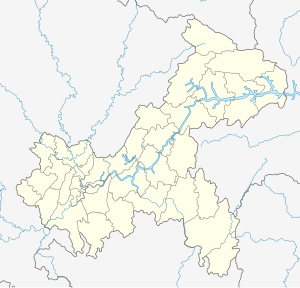Caiyuanba Bridge
Coordinates: 29 ° 32 ′ 36 ″ N , 106 ° 32 ′ 52 ″ E
| Caiyuanba Bridge 菜園壩 大橋 |
||
|---|---|---|
| use | Street and Monorail bridge | |
| Crossing of | Yangtze River | |
| place | Chongqing City | |
| overall length | 800 m | |
| width | 39.8 m | |
| Longest span | 420 m | |
| opening | 2007 | |
| location | ||
|
|
||
| Northern access ramps with a monorail train | ||
The Caiyuanba Bridge ( Chinese 菜園壩 大橋 , Pinyin Càiyuán bà dàqiáo ) is a double-decker bridge that crosses the Yangtze River in Chongqing City, China and connects the Yuzhong district , i.e. the actual city center, with the Nan'an district on the south side of the river .
location
The Yangtze River is 900 m wide at the bridge, where it curves slightly to the left, which is why the deepest gully, the valley path , runs close to the right bank and the left two thirds of the river have only shallow water and occasionally even fall dry. The bridge is still in the area of influence of the reservoir, which is formed by the Three Gorges Dam 450 km further east as the crow flies . Due to its regulation and seasonal flooding, the water level under the bridge can fluctuate by more than 20 m. Navigation is made even more difficult by the Shibanpo Bridge , which is only 1200 m downstream , the older part of which, opened in 1980, has an opening of only 174 m in the fairway.
The Caiyuanba bridge is between two 1.8 km distant distributor rotors to the high banks from which diverse branched elevated roads in the approach bridges pass. Its main opening is directly on the right bank.
description
The Caiyuanba bridge is a combination of a steel arch bridge to concrete framework of steel and a truss -Fahrbahnträger.
It has 2 separate, 12.25 m wide directional lanes with 3 lanes each and a 2.50 m wide sidewalk. On the lower floor there are two lanes for the monorails of line 3 of the Chongqing Rail Transit .
The deck girder of the main bridge is an 800 m long and 11.2 m high continuous girder made of a strut framework and a 39.8 m wide orthotropic slab . It connects the pillars P15 and P20 outside the photo above. The road girders beyond this continuous girder are hollow boxes made of prestressed concrete .
The most noticeable part of the bridge are the two red arches above the roadway. They are 4.0 m high and 2.4 m wide steel box girders with a span of 320 m and an arrow height of 56 m. They are inclined to one another by 10.67 ° relative to the vertical and are stiffened by 6 wind bracings, which are also designed as hollow boxes.
They are supported without joints on the inner struts made of prestressed concrete hollow boxes , which form an extension of the arches to the main pillars P17 and P18. These pillars also support the outwardly cantilevered struts that end at the heads of pillars P16 and P19 and form a solid frame with the continuous beam of the roadway girder . Like a tied arch bridge, the continuous beam absorbs the horizontal tensile forces of the arch, to which it is only connected by the hangers made of parallel wire ropes .
The pillars P15 to P20 have the following center distances: 88 + 102 + 420 + 102 + 88 m.
Web links
- Xiao-Hui LIU: Design and Construction of Caiyuanba Yangtze River Bridge in Chongqing. In: Chinese-Croatian Joint Colloquium, Long Arch Bridges, Brijuni Islands, 10-14 July 2008 , pp. 447–454 (on Wikiwix )
Individual evidence
- ↑ The information in this article is based on the conference contribution by Xiao-Hui LIU: Design and Construction of Caiyuanba Yangtze River Bridge in Chongqing.


